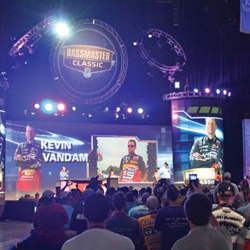
A Real Asset
A staple of the Reel Rock Productions sound inventory is QSC Audio Wide- Line line arrays, which provide very wide 140-degree horizontal dispersion that proved to be a real asset, particularly given the coverage challenges.
Main left and right arrays were each comprised of 16 WideLine-10 modules (dual 10-in, single 1.4-in-exit compression driver), with the bottom portion of each array in a “spiral” configuration to bolster coverage to the very front seats without the need for front fills that would have hampered the stage aesthetic.
The out fill arrays, flown to the sides of the main arrays, were each comprised of eight QSC WideLine-8 modules (dual 8-in, single 1.4-in-exit compression driver).
All of the WideLine models are equipped with a simple 3-point rigging system that allows fast, precise construction of arrays of up to 24 enclosures.
“We keep our WideLines very busy,” Schmidt notes. “They’ve proven to handle all sorts of events quite well. They are perfect for a building block approach – 8 boxes a side, 16 a side, 20 a side, whatever is needed for a given project, and with 140 degrees, you can get a lot done.
It’s very modular, and we tailor the companion amplifier racks to match. It’s quick and clean, fits well within trucks, and it’s all topped by exceptional fidelity.”
This array set was able to cover the entire arena, from top to bottom and side to side, and it was driven by nine racks of amplification that resided behind the stage. The mains were powered by QSC PowerLight PL230 amplifiers, with PL380s amps for the out fills. Everything was driven in bridged mode except the compression drivers. Array height topped out at about 55 feet, well out of sightlines.
Zero Point
The low-frequency portion of the system presented another challenge – there wasn’t a “good” place to put the subwoofers. Schmidt, English, and Cooper implemented a rather novel approach – the system’s eight EAW SB1000 subs (dual 18-in) would be positioned in a stack within a video LED panel at the stage (also driven by PL380 amps).
It was a method they’d utilized on select smaller scale events, and it worked out here as well.
Interestingly, given their positioning at the stage, the subs also served as the system’s “zero point” with respect to timing. In other words, all other loudspeakers were timed in relation to the output of the sub stack, and to further bolster lower frequencies, the main WideLine arrays were run down to 60 Hz.
The end result was truly dynamic output, yet with a high degree of coherence that was free of “rumble.”
The entirely digital signal path from the Yamaha PM5D console at front of house to the backstage racks utilized the QSControl.net networked audio platform. A QSC RAVE 522ua fed nine QSC BASIS 914 and 922 digital processors, with distribution via Cat-5 and overall control with QSC Venue Manager software.
“With the networkable control of the amplifiers, it’s great – all right there, both loudspeaker and overall system processing,” Schmidt says.
“It’s a very powerful package. Take your left and right sends off the desk, put it into RAVE, and then everything is controlled off the network. It’s simple, slick and extremely effective.”
A 360 System Instant Replay machine provided all recorded music tracks for the show, fed directly into the PM5D. Vertuno supplied all vocal mixes, while Cooper handled the music.
Backstage, Apgar stayed very busy as the “mic wrangler,” coordinating the hand-off of Shure UR-4D wireless microphone transmitters to each announcer as the boats approached the stage, in addition to managing more wireless microphones for various MCs and other “talking heads” on stage.
Loud Enough
Saturday night presented an added wrinkle, with country performer Randy Montana and his band performing prior to the weigh-in.
They were provided with a hard-wired microphone package and DIs, as well as QSC K10 and K12 self-powered loudspeakers for monitoring and fill, with about three minutes allotted after their performance to clear the stage.
For Reel Rock Productions/PSG, this initial experience with the Bassmaster Classic proved a success, despite it being their first time serving the event combined with the unique challenges.
“One particularly fun moment was when the client first saw the arrays, and asked if they’d be loud enough,” Schmidt concludes. “I pushed up the main fader, the system absolutely filled the room with full and intelligible sound, and all doubts were erased.
“I have high expectations for everything we do, and I feel we hit the mark. The system performed admirably, we have a happy client, and that’s the whole point.”
Keith Clark is editor-in-chief of Live Sound International and ProSoundWeb.

